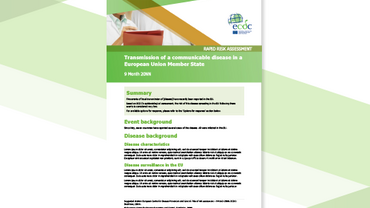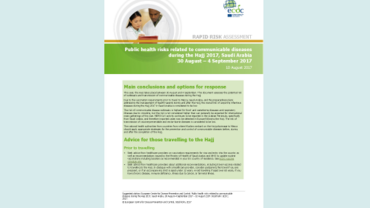Rapid risk assessment: Severe respiratory disease associated with Middle East respiratory syndrome coronavirus (MERS-CoV). Eleventh update, 21 August 2014
The eleventh updated rapid risk assessment on MERS-CoV shows that the number of cases has been steadily declining in the last few months. Following detection of imported cases in Europe, transmission chains have been very limited and appropriate infection control contact tracing methods appear to be effective in limiting further transmission in a European setting. Therefore the current risk of human infections and sustainable human-to-human transmission in Europe remains low.
Executive Summary
Since the last ECDC rapid risk assessment, published on 31 May 2014, the number of incident cases has been steadily declining and from 10 July to 20 August 2014, only two cases of MERS-CoV were reported. The cases currently occurring seem to be sporadic. While the virus continues to circulate in the affected region at a lower frequency, uncertainties in the reservoir of the virus and possible community transmission remain. Following detection of imported cases in Europe, transmission chains have been very limited and appropriate infection control and contact tracing methods appear to be effective in limiting further transmission in a European setting. Extensive contact tracing efforts for flights on which probable or confirmed cases have travelled have so far not shown evidence of transmission to other passengers. Therefore the current risk of human infections and sustainable human-to-human transmission in Europe remains low.
The national healthcare providers and public health institutions should remain prepared for and able to respond to a possible imported case in the EU/EEA. The advice for travellers to affected areas remains the same as it was in the previous (tenth) ECDC risk assessment.
An increasing body of evidence points to dromedary camels as the direct or indirect source of infection for many of the human cases. Gene sequences from the recent camel and human MERS-CoV sequences show no significant mutations compared to previous sequences from this outbreak, and therefore provide no indication of further adaptation to humans as a host. The current pattern of disease appears to be the combination of repeated introductions of the virus from camels to people, resulting in limited, un-sustained, human–to-human transmission. Detection of viral RNA in the air of a camel barn where transmission took place suggests that airborne transmission could be considered as a possible route of transmission together with droplet, contact and fomite transmission.
In response to new available information on MERS-CoV infection, the World Health Organization (WHO) issued updates of surveillance, case definition and laboratory methods in order to achieve early detection of sustained human-to-human transmission and determine the geographic risk area for infection with the virus. More detail and analysis of the events in the Arabian Peninsula is urgently needed to define the source of the infection and to further define the risks posed by this event. The World Health Organization also recommends infection prevention precautions for management of probable and confirmed cases in healthcare facilities, and for care of patients with MERS-CoV infection presenting with mild symptoms as well as management of contacts in home care settings.
The risk-benefit profile of possible experimental or other treatment protocols have been reviewed by Public Health England (PHE) and the International Severe Acute Respiratory and Emerging Infection Consortium (ISARIC). Observational clinical studies are urgently needed to improve the existing knowledge base in these areas.







